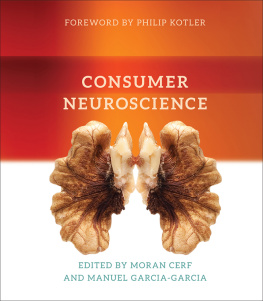Moran Cerf - Consumer Neuroscience
Here you can read online Moran Cerf - Consumer Neuroscience full text of the book (entire story) in english for free. Download pdf and epub, get meaning, cover and reviews about this ebook. year: 2017, publisher: MIT Press, genre: Romance novel. Description of the work, (preface) as well as reviews are available. Best literature library LitArk.com created for fans of good reading and offers a wide selection of genres:
Romance novel
Science fiction
Adventure
Detective
Science
History
Home and family
Prose
Art
Politics
Computer
Non-fiction
Religion
Business
Children
Humor
Choose a favorite category and find really read worthwhile books. Enjoy immersion in the world of imagination, feel the emotions of the characters or learn something new for yourself, make an fascinating discovery.
- Book:Consumer Neuroscience
- Author:
- Publisher:MIT Press
- Genre:
- Year:2017
- Rating:5 / 5
- Favourites:Add to favourites
- Your mark:
- 100
- 1
- 2
- 3
- 4
- 5
Consumer Neuroscience: summary, description and annotation
We offer to read an annotation, description, summary or preface (depends on what the author of the book "Consumer Neuroscience" wrote himself). If you haven't found the necessary information about the book — write in the comments, we will try to find it.
Consumer Neuroscience — read online for free the complete book (whole text) full work
Below is the text of the book, divided by pages. System saving the place of the last page read, allows you to conveniently read the book "Consumer Neuroscience" online for free, without having to search again every time where you left off. Put a bookmark, and you can go to the page where you finished reading at any time.
Font size:
Interval:
Bookmark:

edited by Moran Cerf and Manuel Garcia-Garcia
The MIT Press
Cambridge, Massachusetts
London, England
2017 Massachusetts Institute of Technology
All rights reserved. No part of this book may be reproduced in any form by any electronic or mechanical means (including photocopying, recording, or information storage and retrieval) without permission in writing from the publisher.
This book was set in Melior and MetaPlus by Toppan Best-set Premedia Limited. Printed and bound in the United States of America.
Library of Congress Cataloging-in-Publication Data
Names: Cerf, Moran, editor. | Garcia-Garcia, Manuel, editor.
Title: Consumer neuroscience / Moran Cerf and Manuel Garcia-Garcia.
Description: Cambridge, MA : MIT Press, [2017] | Includes bibliographical references and index.
Identifiers: LCCN 2016059705 | ISBN 9780262036597 (hardcover : alk. paper)
eISBN 9780262341608
Subjects: LCSH: Consumers--Psychology. | Consumer behavior. | Brand choice--Psychological aspects. | Neurons--Physiology. | Neural transmission.
Classification: LCC HF5415.32 .C658673 2017 | DDC 658.8/342--dc23 LC record available at https://lccn.loc.gov/2016059705
ePub Version 1.0
d_r0
I am glad to welcome this comprehensive book on the new field of consumer neuroscience. I want to compliment Professor Moran Cerf for assembling this superb collection of experts on the many aspects of consumer neuroscience.
This book comes after a long history of marketing studies of how consumers make their judgments and their decisions. Marketing scholars were among the first to depart from accepting the economists assumption that consumers always make rational decisions. The idea was that consumers would choose rationally what would serve their best interests. But if this was the case, why would consumers smoke? Why would consumers fail to save enough money for retirement? Why would low-income consumers buy an expensive car when a cheaper car would save them money and get them everywhere they want to go?
We would postulate that many consumers make multiple irrational decisions, by which we mean: decisions that are not objectively in their best interest. The new field of behavioral economics is built on the notion of nonrational decision making and the effort to reason out the sources of such behavior. With the amalgamation of psychology and behavioral economics and the increase in the number of scientists involved in studying the underlying mechanisms of the psychology of behavioral economics, neuroscience has largely contributed recently to our understanding of human psychology in the context of both behavior and decision making (specifically in the applications of those to the business world at large) and marketing.
As one of the leaders in the field, Professor Cerf has shown how neuroscience and its breakthrough understandings of our psychology can contribute to the study of irrational behavior and to improvement in our ability to predict behavior and choice, as well as ways to help us improve them.
An increasing number of consumer companies have adopted these tools to better understand how their customers are reacting to their products, brands, and communications.
This book on consumer neuroscience is the best starting point for marketers, managers, and lay readers to develop a better understanding of how the human mind actually works in transacting with the world of products and services.
Philip Kotler
S. C. Johnson & Son Distinguished Professor of International Marketing
Welcome to the first edition of the textbook Consumer Neuroscience.
The field of consumer neuroscience has grown immensely in recent years, with more businesses electing to entirely replace traditional marketing methods or to enhance the use of neural methods.
Along with these changes, which inevitably bring new skills to the world of marketing, we see an increased movement to more quantitative and data-based marketing at the expense of qualitative methods. Big data, analytics, and statistical inferences are becoming part of everyday marketing solutions, and the requirements for a modern marketing manager exceed those of yesterday.
We expect that being able to use implicit measures of preferences and values will become an ever-growing trend among marketing managers and accordingly offer this book as a first step toward that world.
While the field of consumer neuroscience has grown vastly, the number of textbooks and references in the field falls short. Various popular books offer an overview of the potential and the importance of the field, but none addresses the practical set of information a marketing manager actually needs to know in order to become a significant player in the field.
As such, the majority of solutions are offered by companies, typically mostly made of neuroscientists, who offer a black-box solution. The jargon barriers and the inevitable lack of understanding among the neuroscience community and the marketing community at times generates a gap in the ability to translate the myriad of offerings the field carries into a tangible set of opportunities.
This book, first and foremost, aims to address this problem.
The book is written as a textbook to accompany a class or an educational program that takes a person with no knowledge in neuroscience and carries him or her to an understanding of the tools, techniques, options, and opportunities in this new field. Chapters include discussion questions, case studies, and a variety of examples and summary points that will help an incoming marketing manager to identify a path to understanding the field at his or her level of interest. From a deep mathematical background on the various methods to a broader coverage of the possibilities, we hope that this book will be specific for someone who wants to learn the details of the solutions or all-encompassing if the reader is interested in simply knowing superficially what the field is offering. We hope that readers from many levels will find the book helpful and relevant.
The book is structured in a format that was tried and tested in a number of classes on consumer neuroscience at New York Universitys Stern School of Business, Northwestern Universitys Kellogg School of Management, the Burke Institute, through Coursera, and elsewhere. We hope that the combined years of experience of the authors and collaborators will amount to a useful academic experience for readers.
We begin in chapter 1 with an overview of the field, its place among existing disciplines, and the possibilities and potential for neuroscience to shape consumer insights in the years to come. This chapter, written by Manuel Garcia-Garcia (SVP, Research and Innovation at the Advertising Research Foundation, a nonprofit organization that focuses on assessing the opportunities and possibilities in new technologies to lead the advertising industry to the cutting edge), Moran Cerf (a professor studying consumer neuroscience and business and a consultant to a variety of institutions on the use of implicit measures to gather consumer insights), and Ana Iorga (founder of Buyer Brain, a company specializing in the field of consumer neuroscience), will provide an incoming marketing manager with an understanding of the history and background of the field and highlight the journey we are embarking on together.
In chapter 2, Professors Yuping Chen (National Taiwan University), Ming Hsu (University of California, Berkeley), and Moran Cerf (Kellogg School of Management and the MIT Media Lab) will overview the necessary physiologic systems and terms one needs to know in order to pursue a journey in the field. Without going too broadly into neurophysiology, the authors offer a bridge between the jargon neuroscientists often use in their work and the terminology marketing managers should be aware of to better understand later chapters and interact with the tools available.
Next pageFont size:
Interval:
Bookmark:
Similar books «Consumer Neuroscience»
Look at similar books to Consumer Neuroscience. We have selected literature similar in name and meaning in the hope of providing readers with more options to find new, interesting, not yet read works.
Discussion, reviews of the book Consumer Neuroscience and just readers' own opinions. Leave your comments, write what you think about the work, its meaning or the main characters. Specify what exactly you liked and what you didn't like, and why you think so.












